Posted by: Ken @ 2:12 pm
Among my fondest birding memories are those of spring migration when I was a youngster in New Jersey. The trees were just leafing out, and numerous warblers in vivid plumage adorned the branches. The air was filled with song, and the show changed almost every day, beginning with the early arrivals, such as Myrtle (now called Yellow-rumped), Palm and Black and White Warblers, followed by a slew of other warblers, orioles, buntings, and grosbeaks.
Spring migration can be very slow in our south Florida neighborhood. We are experiencing the gradual departure of most of the small species that spend the winter here. Out-migrants greatly outnumber in-migrants. Gone are the kingfishers, the kestrels, and most of the Yellow-rumped, Prairie and Palm Warblers that were so common during the colder months. Within a few weeks the only bird in our yard that is smaller than a Blue Jay or shrike will be a Red-bellied Woodpecker or an occasional starling. We don’t have any sparrows– not even House Sparrows!
Loggerhead Shrikes are becoming more numerous:
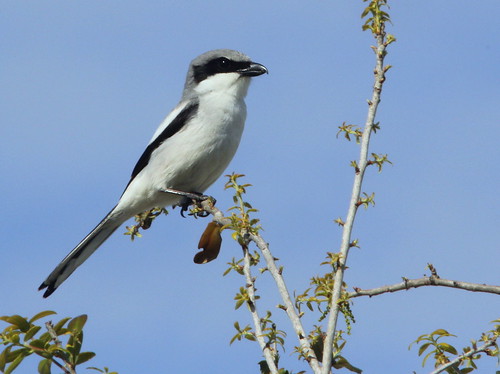
Male Red-winged Blackbirds are being joined by their mates as they relocate to territories in the wetlands:

We live about 18 miles inland from the ocean. Local habitat is badly degraded. Our housing development was gouged out of land that was originally Everglades. Much of it had been drained and put to agricultural use by the middle of the 20th Century.
The homes in our neighborhood were constructed only about 10 years ago, elevated above the flood level on rock and sand, excavated from quarries that became the lakes such as the one in our back yard. To mitigate the environmental damage, the developer had to set aside undeveloped tracts to serve as water conservation areas.
Each home has one mandatory native tree (ours is a Mahogany), but just about every other plant is an exotic. Groomed St. Augustine lawns extend to the very margins of each lake, and alien fruiting and flowering trees and shrubs predominate. The water conservation areas are overrun with invasive Australian Pines and Melaleucas, imported to draw water out of the wetlands, and Brazilian Pepper, an ornamental shrub run amok.
At the western edge of our subdivision, our birding “patch” has one small thicket of mostly exotic shrubs spared by the gardeners, providing shelter for transient migrants:
Prairie Warblers breed in south Florida, especially in coastal areas, and we welcome many additional migrants to our local birding patch. They had been getting scarce since early March, but this week a small flock of warblers moved through the row of Live Oaks that run along the top of the berm (to the right in the above photo).
The flock consisted mostly of Prairie Warblers, which keep their bright yellow plumage all year long:

Among the other warblers were several Northern Parulas, including this male:
Female Northern Parulas lack the black “necklace” of males, but are no less beautiful:
This Prairie Warbler, about to capture a spider, seemed to look curious about my presence, and struck an almost comical pose:
Palm Warblers are the most common small birds around suburban dooryards– some locals call them “Florida Sparrows:”
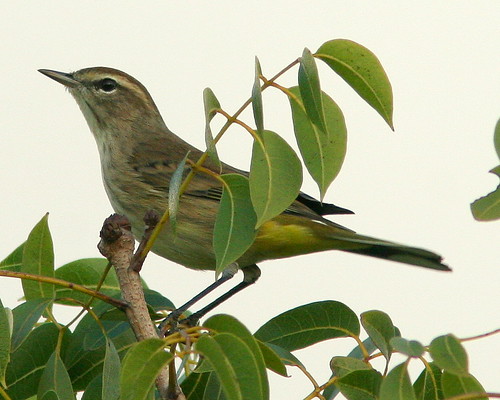
While most Palm Warblers we see here during winter are dull birds of the western population, sometimes a representative of the bright eastern race shows up during migration:
Yellow-rumped Warblers arrive in dull winter and immature plumage, but the males begin to brighten up before departing:
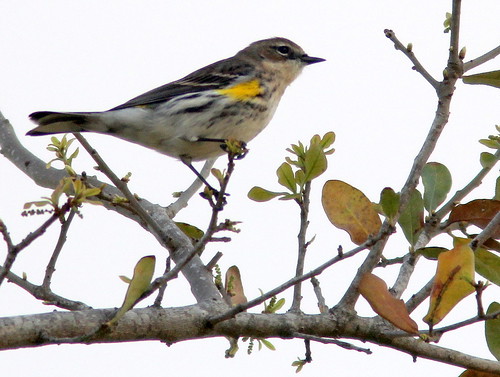
Pine Warblers may be found all year around in suitable pine and mixed forests, but during winter their numbers increase as they are joined by migrants. They may be found locally in ornamental Slash Pines and park land.
A cooperative Pine Warbler posed in a small pine along the boardwalk at nearby Chapel Trail Nature Preserve:
This past week, a five-foot alligator appeared on the undeveloped side of the lake bordering our subdivision. Unless it climbs back over the levee into the wetlands, it will not long for this world. If residents with back yards on the other side see it, they will call for its removal:
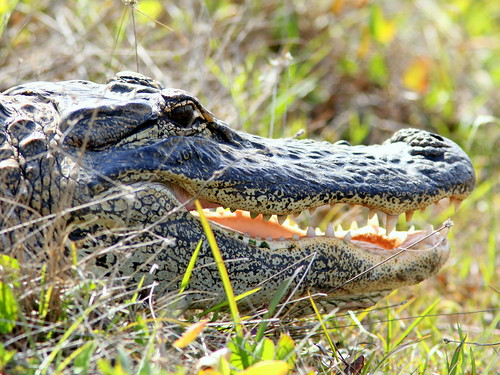
The lack of suitable habitat is not the only reason for our paucity of migrants. In Spring we do not see as many “through-migrants” as we do in the Fall, when southbound birds usually will avoid flying over water until nightfall. Therefore, they wait for favorable weather along the southern tip of the peninsula, and even may back up into our neighborhood. For updated reports and radar images of Florida migration, visit Badbirdz-Reloaded.
In the fall, incoming flocks often become “over-migrants.” The reason? The flight to here from Cuba and the Bahamas is rather short. Cuba is only 90 miles south of the tip of the Florida peninsula. In good flying weather, this is a mere 3 or 4 hour flight for migrating birds. Flocks congregate along Cuba’s north coast. Most depart north shortly after sunset, reaching Florida before midnight. They are able to fly many more miles, overland or along Florida’s coastlines, reaching the northern part of the state by dawn. Those that encounter headwinds or depart Cuba later during the night may stop on the Florida Keys or along the coast at daybreak.













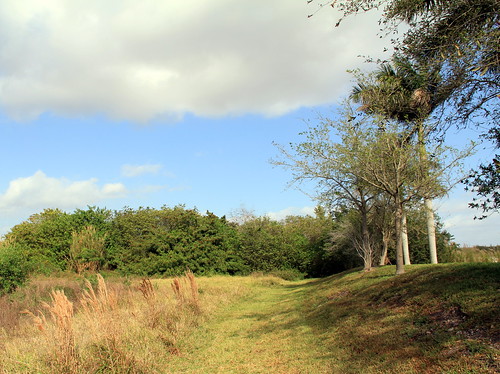

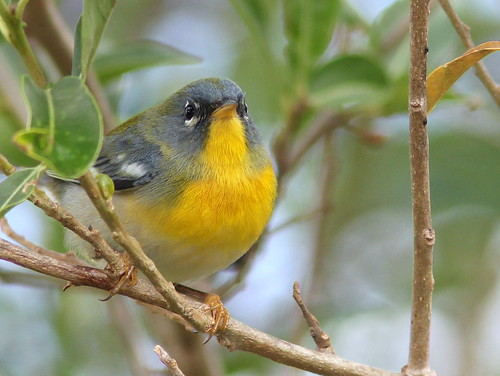
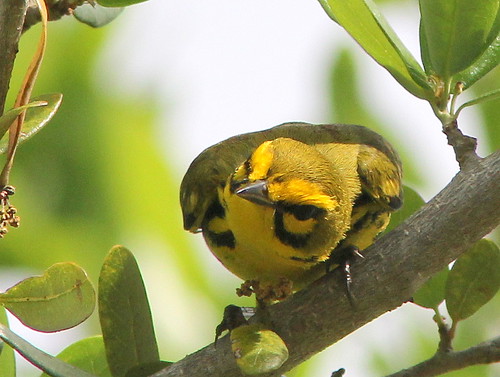

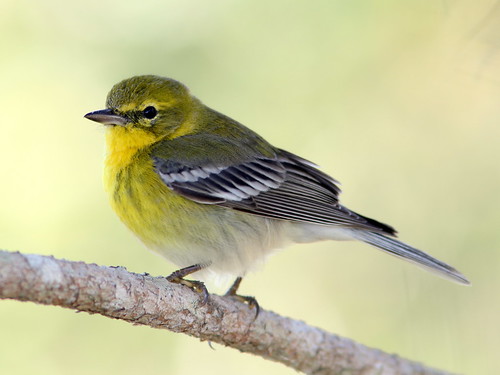
March 29th, 2011 at 8:36 pm Fantastic pictures and post. I love it - I can hardly wait until the warblers show up here.
March 29th, 2011 at 9:41 pm Thanks for another interesting and informative post. While we are no longer in Florida (we had to relocate from beautiful Brevard County to Loudoun County outside DC, which will probably show its charms once spring decides to stay), posts like this help remind me why we want to find our way back there someday, overdevelopment and crazy politics and all.
March 29th, 2011 at 10:05 pm Great photos of all the birds and very interesting description of your habitat and what it has done to the bird-life. Its very hard to stop undesirable development. btw Australian pines (”she oaks” out here) and Melaleuca are perfect in their own environment here in Australia!
March 30th, 2011 at 3:26 am Great series of beautiful birds! Interesting information on the migration.
March 30th, 2011 at 3:28 am Great series!! Boom & Gary of the Vermilon River, Canada.
March 30th, 2011 at 3:57 am Hiya Ken, Always such a treat coming here. I love going through your flickr collection. About “..not long for this world..”: does that mean they put stray alligators down? Or relocate them.
March 30th, 2011 at 9:04 am What a beautiful post! I really feel your longing for the spring In-migration of more temperate realms. Your photography is stunning. There is a quality to it that seems unforced and natural. The birds look comfortable and unconcerned with the presence of a photographer. Just perfect!
March 30th, 2011 at 2:18 pm Wonderful group of photos!
March 30th, 2011 at 2:28 pm Thanks for your kind comments.
Alligators are protected under federal and state law. However anyone can call and ask for them to be removed if they are near private property and feel threatened by their presence.
The Florida FWC has a Statewide Nuisance Alligator Program that contracts with nuisance alligator trappers. Approximately 40 private trappers are contracted to remove specific nuisance alligators. The FWC evaluates each complaint and determine if the alligator should be removed by a licensed nuisance alligator trapper.
An alligator is considered a nuisance when it is at least 4 feet in length and poses a threat to people or their pets or property. Removal generally means “killed.”
On average, Florida FWC receives over 15,000 nuisance alligator complaints and issues 13,000 permits for removal, providing “tags” for each alligator to be removed. An average of 15,000 tags are issued and 7,000 to 9,000 alligators are killed. The average alligator that is killed averages 7 feet.
The program produces approximately 160,000 pounds of alligator meat annually, in addition to that obtained from legally hunted alligators. The current value of raw products (hide, meat, bones) from a 6-7 foot alligator is more than $300, so this can be a profitable business.
March 30th, 2011 at 2:54 pm Stunnings birds, lovely images. Thanks for sharing
March 30th, 2011 at 4:06 pm OHHH I love to see the warblers! Awesome captures of some of my very favorite birds!! Great Gator shot too.
March 31st, 2011 at 4:10 am Beautiful series of bird photos. The warblers are so colorful.